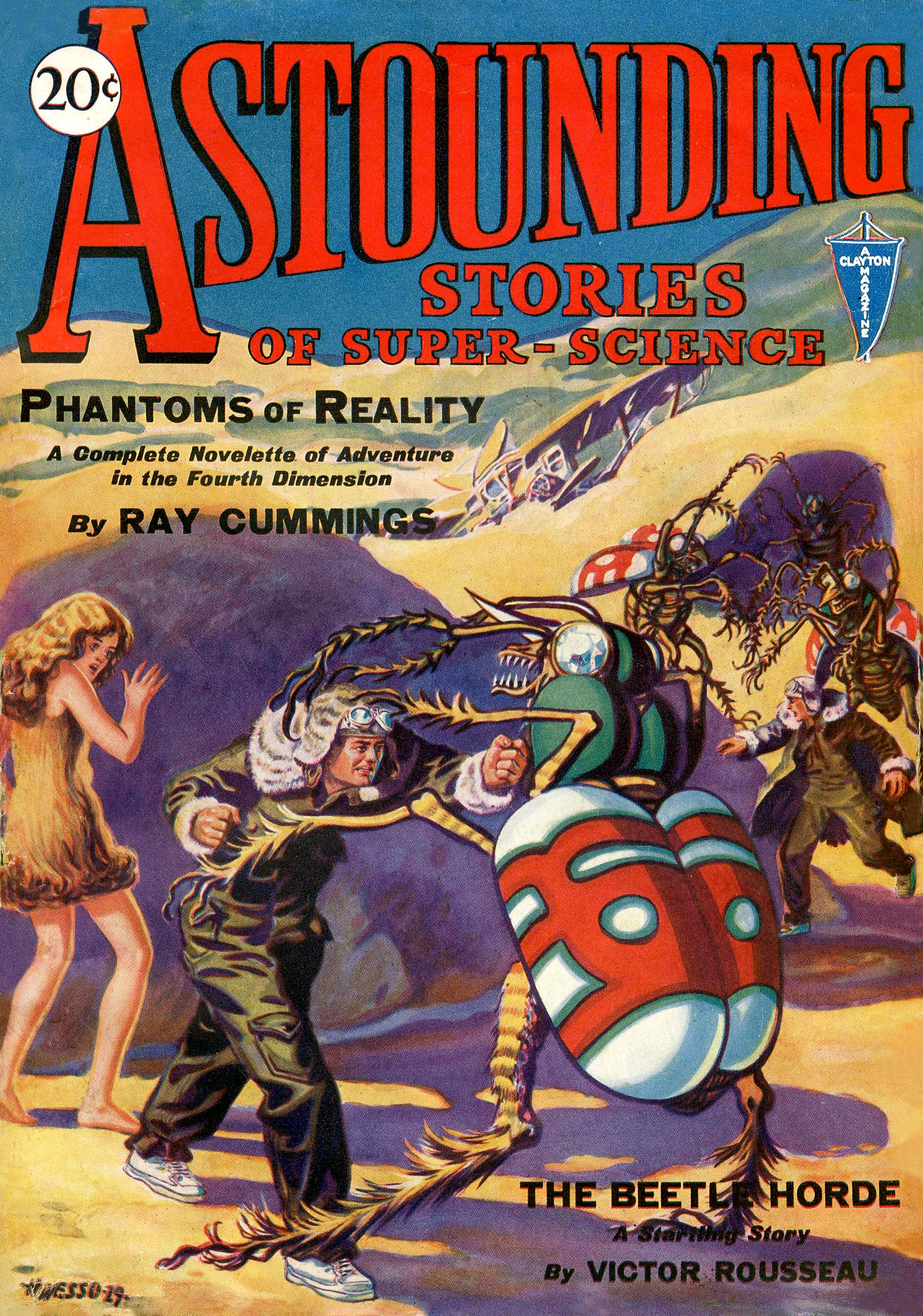|
Sidewise In Time (collection)
''Sidewise in Time'' is a 1950 collection of science fiction short stories by Murray Leinster. It was first published by Shasta Publishers in 1950 in an edition of 5,000 copies. The stories all originally appeared in the magazines ''Astounding'' and ''Thrilling Wonder Stories''. Contents * "Sidewise in Time" * "Proxima Centauri" * "A Logic Named Joe" * "De Profundis" * "The Fourth-Dimensional Demonstrator" *The Power Reception L. Sprague de Camp declared ''Sidewise'' "a fine entertaining collection," although he dismissed "Proxima Centauri" as a "bottom of the trunk" piece."Book Reviews", ''Astounding Science Fiction ''Analog Science Fiction and Fact'' is an American science fiction magazine published under various titles since 1930. Originally titled ''Astounding Stories of Super-Science'', the first issue was dated January 1930, published by William C ...'', February 1951, p.151 References * *{{cite web , last = Contento , first = William G. , authorlink = ... [...More Info...] [...Related Items...] OR: [Wikipedia] [Google] [Baidu] |
WikiProject Novels
A WikiProject, or Wikiproject, is a Wikimedia movement affinity group for contributors with shared goals. WikiProjects are prevalent within the largest wiki, Wikipedia, and exist to varying degrees within sister projects such as Wiktionary, Wikiquote, Wikidata, and Wikisource. They also exist in different languages, and translation of articles is a form of their collaboration. During the COVID-19 pandemic, CBS News noted the role of Wikipedia's WikiProject Medicine in maintaining the accuracy of articles related to the disease. Another WikiProject that has drawn attention is WikiProject Women Scientists, which was profiled by ''Smithsonian Magazine, Smithsonian'' for its efforts to improve coverage of women scientists which the profile noted had "helped increase the number of female scientists on Wikipedia from around 1,600 to over 5,000". On Wikipedia Some Wikipedia WikiProjects are substantial enough to engage in cooperative activities with outside organizations relevant t ... [...More Info...] [...Related Items...] OR: [Wikipedia] [Google] [Baidu] |
Murray Leinster
Murray Leinster (June 16, 1896 – June 8, 1975) was a pen name of William Fitzgerald Jenkins, an American writer of genre fiction, particularly of science fiction. He wrote and published more than 1,500 short stories and articles, 14 movie scripts, and hundreds of radio scripts and television plays. Writing career Leinster was born in Norfolk, Virginia, the son of George B. Jenkins and Mary L. Jenkins. His father was an accountant. Although both parents were born in Virginia, the family lived in Manhattan in 1910, according to the 1910 Federal Census. A high school dropout, he nevertheless began a career as a freelance writer before World War I. He was two months short of his 20th birthday when his first story, "The Foreigner", appeared in the May 1916 issue of H. L. Mencken's literary magazine '' The Smart Set''. Over the next three years, Leinster published ten more stories in the magazine; in a September 2022 interview, Leinster's daughter stated that Mencken recommende ... [...More Info...] [...Related Items...] OR: [Wikipedia] [Google] [Baidu] |
Hannes Bok
Hannes Bok, pseudonym for Wayne Francis Woodard (, ; July 2, 1914 – April 11, 1964), was an American artist and illustrator, as well as an amateur astrologer and writer of fantasy fiction and poetry. He painted nearly 150 covers for various science fiction, fantasy, and detective fiction magazines, as well as contributing hundreds of black and white interior illustrations. Bok's work graced the pages of calendars and early fanzines, as well as dust jackets from specialty book publishers like Arkham House, Llewellyn, Shasta Publishers, and Fantasy Press. His paintings achieved a luminous quality through the use of an arduous glazing process, which was learned from his mentor, Maxfield Parrish. Bok shared one of the inaugural 1953 Hugo Awards for science fiction achievement (best Cover Artist). Life and career Wayne Woodard (the name is sometimes mistakenly rendered as "Woodward") was born in Kansas City, Missouri. His parents divorced when he was five; and his father and st ... [...More Info...] [...Related Items...] OR: [Wikipedia] [Google] [Baidu] |
Science Fiction
Science fiction (sometimes shortened to Sci-Fi or SF) is a genre of speculative fiction which typically deals with imagination, imaginative and futuristic concepts such as advanced science and technology, space exploration, time travel, Parallel universes in fiction, parallel universes, extraterrestrials in fiction, extraterrestrial life, sentient artificial intelligence, cybernetics, certain forms of immortality (like mind uploading), and the technological singularity, singularity. Science fiction List of existing technologies predicted in science fiction, predicted several existing inventions, such as the atomic bomb, robots, and borazon, whose names entirely match their fictional predecessors. In addition, science fiction might serve as an outlet to facilitate future scientific and technological innovations. Science fiction can trace its roots to ancient mythology. It is also related to fantasy, Horror fiction, horror, and superhero fiction and contains many #Subgenres, sub ... [...More Info...] [...Related Items...] OR: [Wikipedia] [Google] [Baidu] |
Shasta Publishers
Shasta Publishers was a science fiction and fantasy small press specialty publishing house founded in 1947 by Erle Melvin Korshak, T. E. Dikty, and Mark Reinsberg, who were all science fiction fans from the Chicago area. The name of the press was suggested by Reinsberg in remembrance of a summer job that he and Korshak had held at Mount Shasta. History As science fiction fans and book collectors, Mel Korshak, Mark Reinsberg, Ted Dikty, and Fred Shroyer recognized the need for a comprehensive list of science fiction and fantasy published up to that time. In 1940 they made plans to compile such a list and began writing letters to the readers' letter columns in the science fiction and fantasy pulp magazines, asking for help with the project; a card file was started, as was a manuscript. Unfortunately, these materials were put into storage when Dikty was drafted for service in World War II. After the war, the file and manuscript were unable to be located, and the work would have to beg ... [...More Info...] [...Related Items...] OR: [Wikipedia] [Google] [Baidu] |
1950 In Literature
This article contains information about the literary events and publications of 1950. Events *January 19 – Isaac Asimov's first full-length novel, ''Pebble in the Sky'', is published in the United States by Doubleday. *January 26 – For the film noir '' Gun Crazy'', released on this day in the United States, co-writer Dalton Trumbo is billed as Millard Kaufman, due to the former's inclusion on the Hollywood blacklist. This year Trumbo serves 11 months in prison for Contempt of Congress, in the federal penitentiary in Ashland, Kentucky. *February – Jack Kerouac has his first novel, '' The Town and the City'', published in the United States. * April 8 – J. D. Salinger's wartime short story " For Esmé — with Love and Squalor" is published in ''The New Yorker''. *May 11 – Eugène Ionesco's first play, '' The Bald Soprano'' is first performed, in Paris. *September 10 – George Bernard Shaw is taken to hospital after fracturing a hip falling out of a tree he was pru ... [...More Info...] [...Related Items...] OR: [Wikipedia] [Google] [Baidu] |
Science Fiction
Science fiction (sometimes shortened to Sci-Fi or SF) is a genre of speculative fiction which typically deals with imagination, imaginative and futuristic concepts such as advanced science and technology, space exploration, time travel, Parallel universes in fiction, parallel universes, extraterrestrials in fiction, extraterrestrial life, sentient artificial intelligence, cybernetics, certain forms of immortality (like mind uploading), and the technological singularity, singularity. Science fiction List of existing technologies predicted in science fiction, predicted several existing inventions, such as the atomic bomb, robots, and borazon, whose names entirely match their fictional predecessors. In addition, science fiction might serve as an outlet to facilitate future scientific and technological innovations. Science fiction can trace its roots to ancient mythology. It is also related to fantasy, Horror fiction, horror, and superhero fiction and contains many #Subgenres, sub ... [...More Info...] [...Related Items...] OR: [Wikipedia] [Google] [Baidu] |
Astounding
''Analog Science Fiction and Fact'' is an American science fiction magazine published under various titles since 1930. Originally titled ''Astounding Stories of Super-Science'', the first issue was dated January 1930, published by William Clayton, and edited by Harry Bates. Clayton went bankrupt in 1933 and the magazine was sold to Street & Smith. The new editor was F. Orlin Tremaine, who soon made ''Astounding'' the leading magazine in the nascent pulp science fiction field, publishing well-regarded stories such as Jack Williamson's '' Legion of Space'' and John W. Campbell's "Twilight". At the end of 1937, Campbell took over editorial duties under Tremaine's supervision, and the following year Tremaine was let go, giving Campbell more independence. Over the next few years Campbell published many stories that became classics in the field, including Isaac Asimov's ''Foundation'' series, A. E. van Vogt's ''Slan'', and several novels and stories by Robert A. Heinlei ... [...More Info...] [...Related Items...] OR: [Wikipedia] [Google] [Baidu] |
Thrilling Wonder Stories
''Wonder Stories'' was an early American science fiction magazine which was published under several titles from 1929 to 1955. It was founded by Hugo Gernsback in 1929 after he had lost control of his first science fiction magazine, ''Amazing Stories'', when his media company Experimenter Publishing went bankrupt. Within a few months of the bankruptcy, Gernsback launched three new magazines: ''Air Wonder Stories'', ''Science Wonder Stories'', and ''Science Wonder Quarterly''. ''Air Wonder Stories'' and ''Science Wonder Stories'' were merged in 1930 as ''Wonder Stories'', and the quarterly was renamed ''Wonder Stories Quarterly''. The magazines were not financially successful, and in 1936 Gernsback sold ''Wonder Stories'' to Ned Pines at Beacon Publications, where, retitled ''Thrilling Wonder Stories'', it continued for nearly 20 years. The last issue was dated Winter 1955, and the title was then merged with ''Startling Stories'', another of Pines' science fiction magazines. ' ... [...More Info...] [...Related Items...] OR: [Wikipedia] [Google] [Baidu] |
Sidewise In Time
"Sidewise in Time" is a science fiction short story by American writer Murray Leinster that was first published in the June 1934 issue of ''Astounding Stories''. "Sidewise in Time" served as the title story for Leinster's second story collection in 1950. The Sidewise Award for Alternate History, established in 1995 to recognize the best alternate history stories and novels of the year, was named in honor of "Sidewise in Time". Plot summary Professor Minott is a mathematician at Robinson College in Fredericksburg, Virginia who has determined that an apocalyptic cataclysm is fast approaching that could destroy the entire universe. The cataclysm manifests itself on June 5, 1935 (one year in the future of the story's original publication) when sections of the Earth's surface begin changing places with their counterparts in alternate timelines. A Roman legion from a timeline where the Roman Empire never fell appears on the outskirts of St. Louis, Missouri. Viking longships from a t ... [...More Info...] [...Related Items...] OR: [Wikipedia] [Google] [Baidu] |
Proxima Centauri (short Story)
"Proxima Centauri" is a science fiction short story by American writer Murray Leinster, originally published in the March 1935 issue of '' Astounding Stories''. Unusually for the time, the story adhered to the laws of physics as they were known by showing a starship that was limited by the speed of light and took several years to travel between the stars. In his comments on the story in ''Before the Golden Age'', Isaac Asimov thought that "Proxima Centauri" must have influenced Robert A. Heinlein's later story " Universe" and stated that it influenced his own ''Pebble in the Sky''. Plot summary Earth's first starship, the ''Adastra'', is approaching Proxima Centauri after a seven-year voyage. The voyage was marred by a mutiny among the crew, and the ship is still divided between a small group of officers that controls the ''Adastra'' and the remainder of the crew, whom the officers refer to disparagingly as Muts, short for mutineers. A young Mut, named Jack Gary, has been pi ... [...More Info...] [...Related Items...] OR: [Wikipedia] [Google] [Baidu] |




